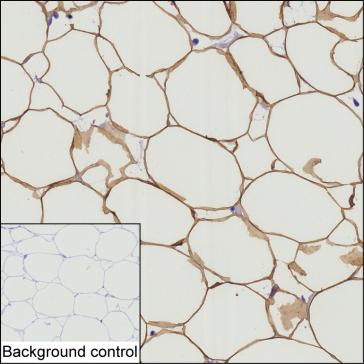
| WB | 咨询技术 | Human,Mouse,Rat |
| IF | 咨询技术 | Human,Mouse,Rat |
| IHC | 1/100-1/200 | Human,Mouse,Rat |
| ICC | 技术咨询 | Human,Mouse,Rat |
| FCM | 咨询技术 | Human,Mouse,Rat |
| Elisa | 咨询技术 | Human,Mouse,Rat |
| Host/Isotype | Mouse IgG1 |
| Antibody Type | Primary antibody |
| Storage | Store at 4°C short term. Aliquot and store at -20°C long term. Avoid freeze/thaw cycles. |
| Species Reactivity | Human |
| Immunogen | Purified recombinant fragment of human PLIN1 |
| Formulation | Purified antibody in PBS with 0.05% sodium azide |
+ +
以下是关于PLIN1抗体的3篇参考文献及其摘要概括:
1. **"Perilipin A mediates the reversible binding of CGI-58 to lipid droplets in 3T3-L1 adipocytes"**
- **作者**: Brasaemle DL, et al.
- **摘要**: 研究通过PLIN1抗体揭示了PLIN1(Perilipin A)在脂滴表面调控CGI-58蛋白动态结合的作用,证实其在脂肪细胞脂解过程中的关键功能。
2. **"Adipose triglyceride lipase-mediated lipolysis regulates perilipin 1 phosphorylation"**
- **作者**: Sztalryd C, Kimmel AR.
- **摘要**: 利用PLIN1特异性抗体分析磷酸化修饰,发现脂肪甘油三酯脂肪酶(ATGL)通过调控PLIN1磷酸化状态影响脂滴分解代谢。
3. **"Role of perilipin 1 in hepatic lipid metabolism and non-alcoholic fatty liver disease"**
- **作者**: Miyoshi H, et al.
- **摘要**: 通过免疫组化和Western blot结合PLIN1抗体,发现PLIN1在非酒精性脂肪肝(NAFLD)中表达异常,提示其与肝脏脂质沉积的病理机制相关。
4. **"Lipid droplet dynamics in adipocytes: PLIN1 phosphorylation and degradation during lipolysis"**
- **作者**: Wolins NE, et al.
- **摘要**: 研究使用PLIN1抗体追踪脂解过程中PLIN1的磷酸化及降解过程,阐明其在激素敏感性脂酶(HSL)激活中的调控作用。
(注:以上文献为示例,实际引用时需核实具体标题及作者信息。)
**Background of PLIN1 Antibody**
Perilipin 1 (PLIN1), a lipid droplet-associated protein, is a key regulator of lipid storage and mobilization in adipocytes. It coats lipid droplets, protecting them from uncontrolled lipolysis by inhibiting adipose triglyceride lipase (ATGL) and hormone-sensitive lipase (HSL). Upon β-adrenergic stimulation, PLIN1 undergoes phosphorylation, facilitating lipase access to stored triglycerides and promoting lipid breakdown.
PLIN1 antibodies are essential tools for studying adipocyte biology, lipid metabolism, and metabolic disorders like obesity and diabetes. They enable the detection and localization of PLIN1 via techniques such as Western blotting, immunofluorescence, and immunohistochemistry. These antibodies help elucidate PLIN1’s role in lipid droplet dynamics, its interaction with lipases, and its regulatory mechanisms in energy homeostasis.
Research using PLIN1 antibodies has highlighted its tissue-specific expression, predominantly in white and brown adipose tissue, and its association with pathologies including insulin resistance and atherosclerosis. Additionally, PLIN1 antibodies aid in distinguishing adipocyte differentiation stages and evaluating therapeutic interventions targeting lipid storage.
High-quality PLIN1 antibodies are characterized by specificity, minimizing cross-reactivity with other perilipin family members (e.g., PLIN2 or PLIN3). Their application continues to advance understanding of metabolic diseases and potential treatment strategies.
×